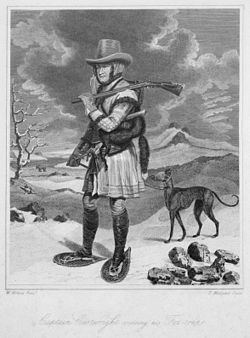Name George Cartwright | Role Trader | |
 | ||
Books A journal of transactions and events, during a residence of nearly sixteen years on the coast of Labrador | ||
George cartwright some nuance
George Cartwright (12 February 1739/40 – 19 May 1819) was an English army officer and a trader and explorer in Newfoundland and Labrador. His name is borne by Cartwright, a settlement at the entrance to Sandwich Bay, Newfoundland and Labrador.
Contents
- George cartwright some nuance
- Early Life and Family
- Army career
- Voyages to Newfoundland and Labrador
- Later life in England
- References
Early Life and Family
George Cartwright was born at Marnham in Nottinghamshire, England, an elder brother of Edmund Cartwright, clergyman and inventor of the power loom, and of John Cartwright, naval officer and English parliamentary reformer.
Army career
Cartwright became a gentleman cadet in the Royal Military Academy at Woolwich, London when he was fifteen. He served in India as ensign in the 39th Foot. In 1759, he was promoted lieutenant while in Ireland. In 1760 he was aide-de-camp to the Marquess of Granby in Germany and a staff officer under Duke Ferdinand of Brunswick. He was brevetted captain in 1762, returned to England and went on half pay from 1762 to 1766. In 1766, Cartwright was commissioned Captain in the 37th Foot, and went to Minorca during 1766 and 1767.
Voyages to Newfoundland and Labrador
George Cartwright's brother John Cartwright was first lieutenant on HMS Guernsey. In the 1766 season, George Cartwright cruised the Newfoundland coast on this vessel with his brother.
In 1768, George Cartwright went to Newfoundland again and accompanied John Cartwright's voyage attempting to contact the Beothuk people on the Exploits river.
Between 1770 and 1786, Cartwright occupied a number of fishing and furring stations from Cape Charles to Sandwich Bay and developed connections with the Inuit and Innu people there. His financial successes was mixed at best, and his many setbacks included being thoroughly raided by American privateers in 1778. This came about when his servant Dominick Kinnien defected to join the crew of the Bostonian John Grimes.
In 1772, five Inuit people traveled with Cartwright to Ireland and England, where they were a sensation, drawing the attention of King George III, Joseph Banks, John Hunter, James Boswell, Samuel Johnson, and great crowds. Tragically, four of these people died of smallpox before returning home. The sole survivor was Caubvick, who is now the namesake of Mount Caubvick.
Later life in England
In 1786, Cartwright returned to England. He published his diary in 1792 and continued to be interested in the politics and business of Labrador. He was barracks master of the Nottingham Militia from some time during the Napoleonic Wars until 1817. He died in 1819 in Mansfield, England. He had an unparalleled love for Labrador until his death — as is shown, for example, in his lengthy and somewhat tedious piece of verse, of which this is a small extract:
Fish, Fowl and Ven’son now our tables grace:Roast Beaver too, and ev’ry Beast of Chase.Luxurious living this! who'd wish for more?Were Quin alive, he'd haste to Labrador!Cartwright died at Mansfield, Nottinghamshire. At Cartwright, Labrador, there is a substantial monument commemorating him and his brother John. Part of the inscription reads: "In Memory of George Cartwright, Captain in his Majesty's 37th Regiment of Foot ... who in March 1770 made a settlement on the coast of Labrador ... also of John Cartwright, Lieutenant of the Guernsey ...".
